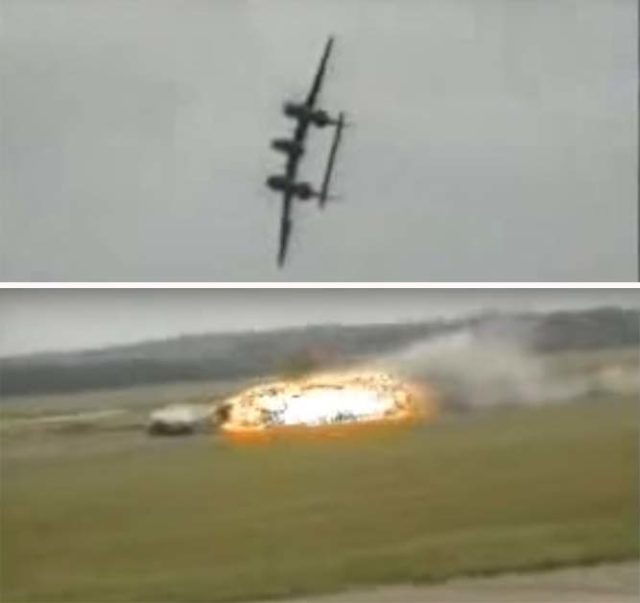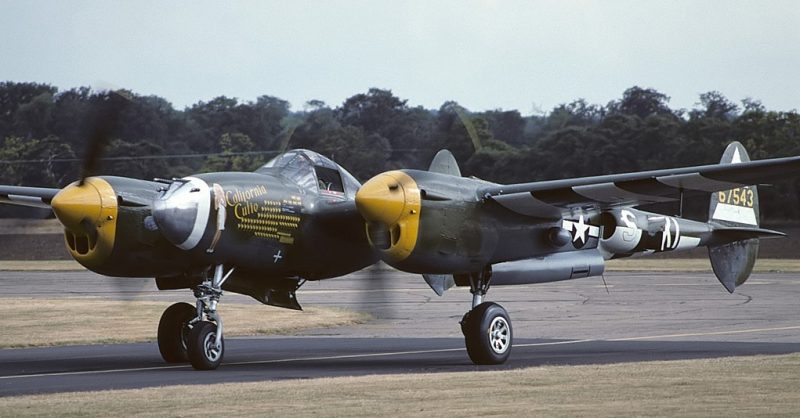The only Lockheed P-38 Lightning that was flyable in Europe was completely destroyed when it crashed at Duxford Airfield near Cambridge, England. The crash occurred as it participated in the Flying Legends Airshow, on July 15, 1996.
The plane’s pilot died instantly in the crash. The plane was from The Fighter Collection, which was owned by the warbird enthusiast from Britain Stephen Grey. It was being flown by the Collection’s chief pilot Michael Bryan “Hoof” Proudfoot, a 54-year-old native of England.
Eyewitnesses said that the plane was unable to regain control after a low-level roll. It then ended up striking the approach end of the paved runway there at Duxford. The plane exploded immediately upon impact, then tumbled into a parking area for transient civilian aircraft that were parked next to the runway on grass.
Eight aircraft parked there were completely destroyed during the crash, and six others suffered major damage. Proudfoot, who died in the initial impact, was the first fatality on record at that flying show.
Having enlisted as an electronics technician with the Royal Air Force in 1958, Proudfoot was chosen to move on to pilot training just three years later. When stationed in the Far East, he flew Hawker Hunters. He was also among the first pilots to ever fly a VTOL Harrier.
After three years of flying with the U.S. Marine Corps in Cherry Point, NC, he was promoted to the role of Squadron Leader. At that time he was given a staff job at the Strike Command of the Royal Air Force. Because he didn’t like sitting behind a desk, he resigned to take a job flying for Brittania Airways.
Both of Proudfoot’s sons became professional pilots, and one is a first officer with British Airways. Despite the devastation of the wreckage, the damage could have been even worse. The P-38 just missed three B-25 bombers that were waiting near the runway end as 10 P-51 Mustangs were taking off. An unconfirmed rumor was that the unrecoverable roll could have been the result of an asymmetrical flap extension or aileron failure by the P-38.

There was a strong California connection for the P-38. Besides being called “California Cutie” – the name on its nose – it was built in Burbank and then restored in Chino for its owner. Having rolled off Lockheed’s production line in October 1943 with serial number 42-67543, it was a P-38J. It was later converted to an F-5C photo reconnaissance plane at the Dallas Love Field Facility. After it had made several stateside postings during the war, it ended up in storage before being sold to a private owner in the Austin, Texas area.
After being vandalized and mistreated for more than a decade as it sat in Austin, the well-known P-38 pilot Lefty Gardner bought the plane’s hulk in the mid-1960s. The untouched airframe was then bought by Stephen Grey in 1988.
Grey hired Steve Hinton’s Fight Rebuilders to return the plane to flying condition. It was purchased in terrible condition with the rebuild being finished in 1992. The plane had completed a test flight before it was shipped to England.
The plane was flown for two seasons at P-38 ace Jack Ilfrey’s plane known as the “Happy Jack’s Go Buggy” as part of The Fighter Collection. A couple of years later, it was painted a drab olive color accented with spinners of a yellow color to represent “California Cutie”, the plane flown by Lt. Dick Loenhart in 1944.
Video
The crash was caught on camera
